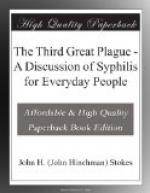+Effect of Hereditary Syphilis on the Unborn Child.+—In the effect of hereditary syphilis on the child, we see the most direct illustration of the deteriorating influence of the disease on the race. Here again we must allow for wide variation, dependent on circumstances and on differences in the course of the disease. This does not, however, conceal the tragedy expressed in the statement that, under anything but the most expert care, more than 75 per cent of the children born with syphilis die within the first year of life. Good estimates show that more often 95 per cent than fewer of untreated children die. Such figures as those of Still are not at all exceptional—of 187 children of syphilitic parents, born or unborn, 113 were lost, whether by miscarriage, still-birth, or in spite of treatment after they were born. It is estimated that not more than 28 per cent of syphilitic children survive their first year. Those that survive the first year seem to have a fighting chance for life. Statistics based on over 100,000 cases show that about one child in every 148 from two to twelve years of age has hereditary syphilis. Realizing the difficulty in recognizing the disease by examination alone, it is entirely safe to suppose that the actual figures are probably higher. The statistics given at least illustrate how few syphilitic children survive to be included in such an estimate.
+Moral Effect on the Parents.+—The real extent of the damage done by the disease as a cause of death in infancy is scarcely appreciated from figures alone. There is something more to be reckoned with, which comes home to every man or woman who has ever watched for the birth of a child and planned and worked to make a place for it in the world. The loss or crippling of the new-born child jars the character and morale of the father and mother to the root. When the object of these ideals dies, something precious and irreplaceable is taken from the life of the world. The toll of syphilis in misery, in desolation, in heart-breakings, in broken bonds and defeated ideals can never be estimated in numbers or in words.
+Course of Hereditary Syphilis in the Infant.+—The course of syphilis in the child tends to follow certain general lines. The disease, being contracted before birth, shows its most active manifestations early in life. The stillborn child is dead of its disease. The living child may be born with an eruption, or it may not develop it for several weeks or months. It is thought by some that these delayed eruptions represent infections at birth. Hereditarily syphilitic children are filled with the spirochetes, the germs of the disease. They are in every tissue and organ; the child is literally riddled with them. In spite of this it may for a time seem well. The typical syphilitic child, however, is thin, weak, and wasted. Syphilis hastens old age even in the strong. It turns the young child into an old man or woman at birth. The skin is wrinkled,




